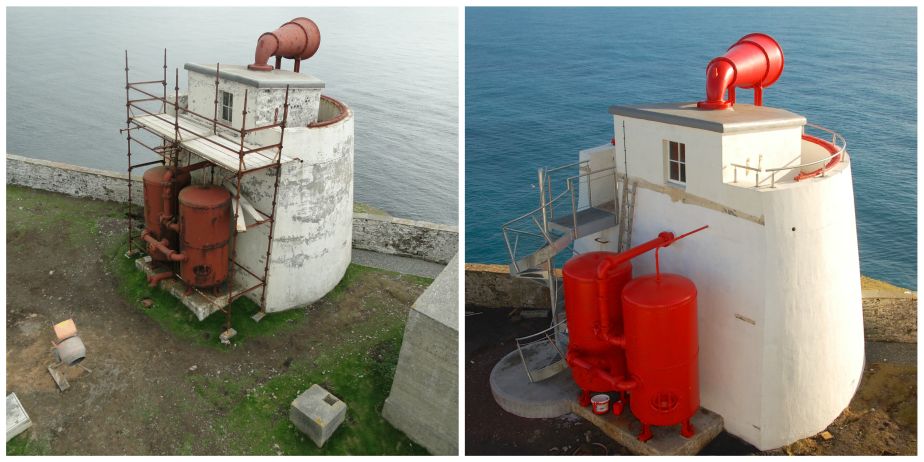Press releases
The Sumburgh Head Foghorn, located at the southern tip of the Mainland of Shetland, was awarded a prestigious Engineering Heritage Award by the Institution of Mechanical Engineers on Friday 30 September.
The award was presented at a special ceremony by Past President of the Institution of Mechanical Engineers Bill Edgar to John Mackenzie from the Shetland Amenity Trust who managed the restoration of the Foghorn and other Lighthouse Buildings between 2012 and 2014. Also in attendance will be Brian Johnson who was responsible for the repair and restoration of the foghorn itself during the wider restoration works on the site. Brian worked for many years as an occasional keeper and lighthouse engineer for the Northern Lighthouse Board, he joined the Trust in 2007 and although now retired, he still keeps the foghorn operational.
Previous winners of Engineering Heritage Awards include Alan Turing’s Bombe at Bletchley Park, the E-Type Jaguar and the fastest ever Concorde.
Bill Edgar, Past President of the Institution of Mechanical Engineers, said:
“The Sumburgh Head Foghorn is a magnificent feat of engineering that helped ensure safe passage for countless sailors navigating the North Sea for over 80 years.
“But this award not only honours the great feats of the engineers who created the horn but also the wonderful work of John Mackenzie and the rest of his team at the Shetland Amenity Trust who restored the foghorn to the wonderful condition it is in today.”
John Mackenzie, from the Shetland Amenity Trust, said:
“As a chartered civil engineer, I am so pleased to be tasked with receiving this award on behalf of Shetland Amenity Trust and the Sumburgh Head project. At the outset of the Sumburgh Head project we had a vision to create something special. Shetland Amenity Trust has received many awards for various projects, this is the first engineering award that the Trust has received, is arguably the most prestigious of all and surpasses our expectations. The award is a just reward for all the hard work and great teamwork from the design team, contractors and Trust staff, with special thanks due to our own ‘lighthouse artificer’ Brian Johnson and the Mechanical and Electrical staff at Irons Foulner Consulting Engineers Ltd.” ”
Although foghorns are now obsolete in modern shipping, they played a very important part in the history of maritime safety. The sound of the Sumburgh Foghorn is powered by low pressure compressed air, generated by Alley & MacLellan compressors, driven by the three engines in the Engine Room. The blast is controlled by an air driven clockwork mechanism which operates valves in the correct sequence and at the correct time to spin a siren rotor, housed within the siren chest. At the right time, a cam operates a valve which causes air to lift a diaphragm valve allowing the full flow of air to pass through the siren – rotating at 1200rpm – thus creating the ‘blast’ noise for the seven second period, then closing the diaphragm valve to stop the sound. The sound is amplified by the trumpet on top of the tower and in the case of Sumburgh Head, this can be heard as far away as Fair Isle, some 37 miles away.
The foghorn at Sumburgh Head last sounded in 1987, just before the automation of the Lighthouse Tower and the last Keeper left his post in 1991. The light is now operated remotely from the Northern Lighthouse Board offices in Edinburgh.
Following extensive repair and restoration, on Thursday 15 January 2015, the final stage of testing was carried out on the Sumburgh foghorn. After previous 'silent' tests where air was passed through the horn with no sound, the motor was engaged and the horn sounded out over the sea for the first time in 28 years.

The Institution of Mechanical Engineers was established in 1847 and has some of the world’s greatest engineers in its history books. It is one of the fastest growing professional engineering institutions. Headquartered in London, we have operations around the world and over 113,000 members in more than 140 countries working at the heart of the most important and dynamic industries such as the automotive, rail, aerospace, medical, power and construction industries.
The Engineering Heritage Awards, established in 1984, aim to promote artefacts, sites or landmarks of significant engineering importance – past and present.